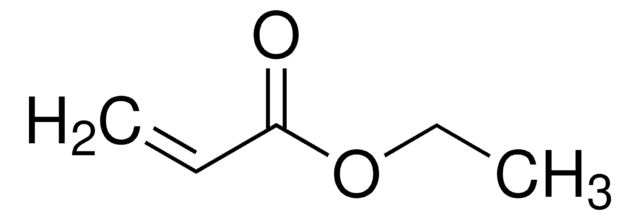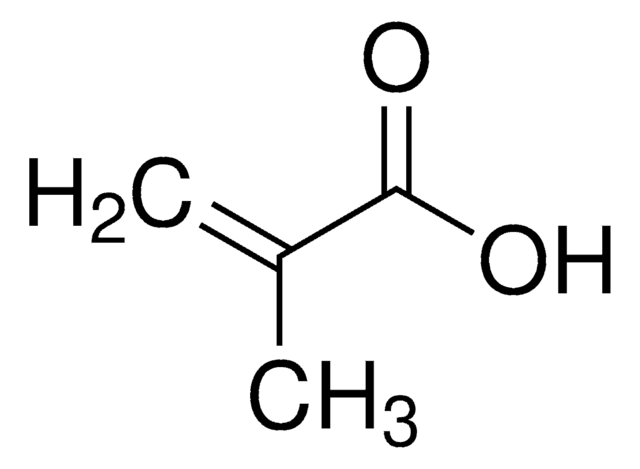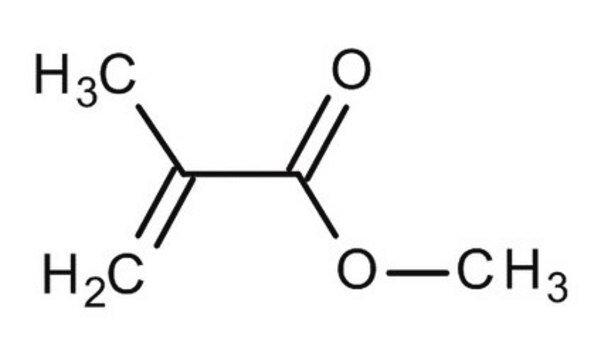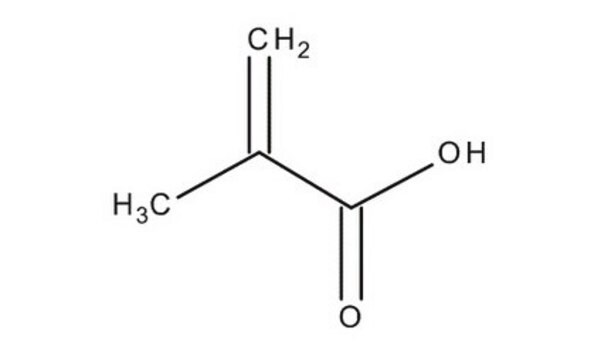W241811
Ethyl acrylate
≥99.5%, stabilized
Synonyme(s) :
Acrylic acid ethyl ester, Ethyl 2-propenoate
About This Item
Produits recommandés
Source biologique
synthetic
Niveau de qualité
Qualité
Kosher
Conformité réglementaire
FDA 21 CFR 117
Densité de vapeur
3.5 (vs air)
Pression de vapeur
31 mmHg ( 20 °C)
Essai
≥99.5%
Forme
liquid
Température d'inflammation spontanée
721 °F
Contient
10-30 ppm MEHQ as stabilizer (synthetic)
Limite d'explosivité
12.1 %
Indice de réfraction
n20/D 1.406 (lit.)
pb
99 °C (lit.)
Pf
−71 °C (lit.)
Densité
0.918 g/mL at 25 °C (lit.)
Application(s)
flavors and fragrances
Documentation
see Safety & Documentation for available documents
Allergène alimentaire
no known allergens
Propriétés organoleptiques
plastic
Chaîne SMILES
CCOC(=O)C=C
InChI
1S/C5H8O2/c1-3-5(6)7-4-2/h3H,1,4H2,2H3
Clé InChI
JIGUQPWFLRLWPJ-UHFFFAOYSA-N
Vous recherchez des produits similaires ? Visite Guide de comparaison des produits
Description générale
Application
- Refractive index adjustable intraocular lens design to achieve diopter control for improving the treatment of ametropia after cataract surgery.: This study involves the use of ethyl acrylate in developing intraocular lenses with adjustable refractive indices, which aims to improve visual outcomes in patients undergoing cataract surgery by providing customizable diopter control (Hong et al., 2024).
Clause de non-responsabilité
Mention d'avertissement
Danger
Mentions de danger
Conseils de prudence
Classification des risques
Acute Tox. 3 Inhalation - Acute Tox. 4 Dermal - Acute Tox. 4 Oral - Aquatic Chronic 3 - Eye Irrit. 2 - Flam. Liq. 2 - Skin Irrit. 2 - Skin Sens. 1 - STOT SE 3
Organes cibles
Respiratory system
Code de la classe de stockage
3 - Flammable liquids
Classe de danger pour l'eau (WGK)
WGK 2
Point d'éclair (°F)
48.2 °F - closed cup
Point d'éclair (°C)
9 °C - closed cup
Faites votre choix parmi les versions les plus récentes :
Déjà en possession de ce produit ?
Retrouvez la documentation relative aux produits que vous avez récemment achetés dans la Bibliothèque de documents.
Les clients ont également consulté
Notre équipe de scientifiques dispose d'une expérience dans tous les secteurs de la recherche, notamment en sciences de la vie, science des matériaux, synthèse chimique, chromatographie, analyse et dans de nombreux autres domaines..
Contacter notre Service technique










